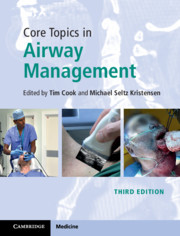Book contents
- Core Topics in Airway Management
- Core Topics in Airway Management
- Copyright page
- Contents
- Contributors
- Foreword
- Preface to the Third Edition
- Section 1 Airway Management: Background and Techniques
- Section 2 Airway Management: Clinical Settings and Subspecialties
- Section 3 Airway Management: Organisation
- Chapter 34 Departmental and Hospital Organisation
- Chapter 35 Training in Airway Management
- Chapter 36 Human Factors in Airway Management
- Chapter 37 Decontamination of Airway Equipment
- Chapter 38 Airway Management in a Respiratory Epidemic or Pandemic
- Index
- References
Chapter 38 - Airway Management in a Respiratory Epidemic or Pandemic
from Section 3 - Airway Management: Organisation
Published online by Cambridge University Press: 03 October 2020
- Core Topics in Airway Management
- Core Topics in Airway Management
- Copyright page
- Contents
- Contributors
- Foreword
- Preface to the Third Edition
- Section 1 Airway Management: Background and Techniques
- Section 2 Airway Management: Clinical Settings and Subspecialties
- Section 3 Airway Management: Organisation
- Chapter 34 Departmental and Hospital Organisation
- Chapter 35 Training in Airway Management
- Chapter 36 Human Factors in Airway Management
- Chapter 37 Decontamination of Airway Equipment
- Chapter 38 Airway Management in a Respiratory Epidemic or Pandemic
- Index
- References
Summary
The virus responsible for the coronavirus-19 pandemic is predominantly spread by droplet and contact routes of transmission. Many airway management interventions, particularly when applying positive pressure to the airway, generate aerosol particles which pose a further risk of airborne viral transmission. The fundamental principles of airway management in the setting of a respiratory epidemic are not changed but it is essential to maximise safety for both the patient and all staff involved in caring for them. The airway manager should fully understand and apply principles of infection prevention and control, including understanding and matching personal protective equipment (PPE) to the prevailing mode of viral transmission. Airway management should be meticulously planned, safe for the patient and staff, be undertaken by skilled operators using reliable, well-practised techniques and should aim to achieve high first-attempt success rates so that securing the airway is timely and swift.
- Type
- Chapter
- Information
- Core Topics in Airway Management , pp. 321 - 330Publisher: Cambridge University PressPrint publication year: 2020



